Introduction
- Organizational theories are applied in businesses to transform performance.
- Empowered and mentored employees will deliver positive results in a timely manner.
- McGregor’s Theory X and Theory Y has is applicable in both business organizations and people’s lives (Eisenberg, Trethewey, LeGreco, & Goodall, 2016).
- Leaders and individuals should be aware of this model if they want to emerge successful.
- This paper gives a detailed analysis, strengths, and weaknesses of this theory.
- It goes further to describe how people can apply the model in their personal experiences and careers.
Within the past eight decades, different organizational theories have emerged to inform behaviors and cultural practices in business firms. The ultimate objective is to ensure that workers are involved and willing to deliver positive results in their respective companies. McGregor’s Theory X and Theory is a powerful model that guides leaders to achieve their potential.
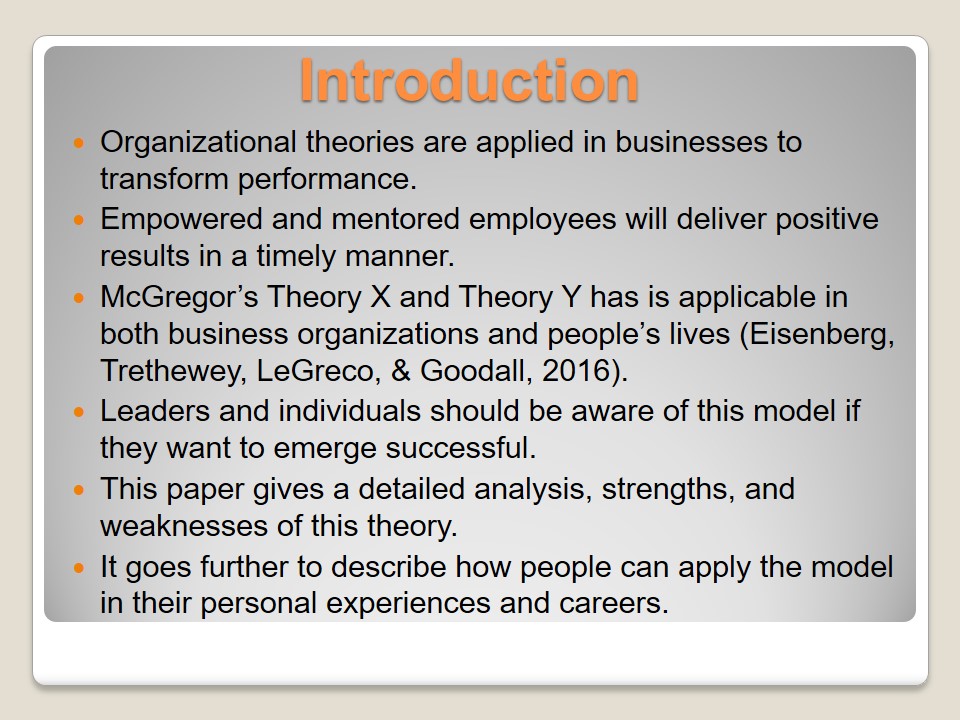
Definitions
- McGregor’s Theory X and Theory Y is subdivided into two parts.
- These include Theory X and Theory Y (Eisenberg et al., 2016).
- Theory X indicates that average human beings do not like work.
- They should be coerced and directed in order to deliver results.
- They avoid responsibility and focus mainly on security.
- The use of this model will affect organizational performance.
- Theory Y is the second part of this model.
- It is an alternative to Theory X since it compares mental effort with rest or play (Eisenberg et al., 2016).
- Punishment is not essential to deliver positive objectives.
- Human beings can learn to accept and seek additional responsibilities.
- Many people are usually willing to exercise and promote creativity.
- The average man is presently underutilized in this modern industrial era.
Theory X indicates many people are naturally opposed to career engagements or work. This means that those in power should punish or coerce them to complete their duties diligently or in a timely manner. Punishments and rewards will support this kind of practice.
This framework becomes a better alternative since it focuses on human value and the best strategies to improve personal or organizational results. It asserts that many people who target challenging environments will eventually realize their aims. With proper support and guidance, employees can become fruitful and make their organizations successful.
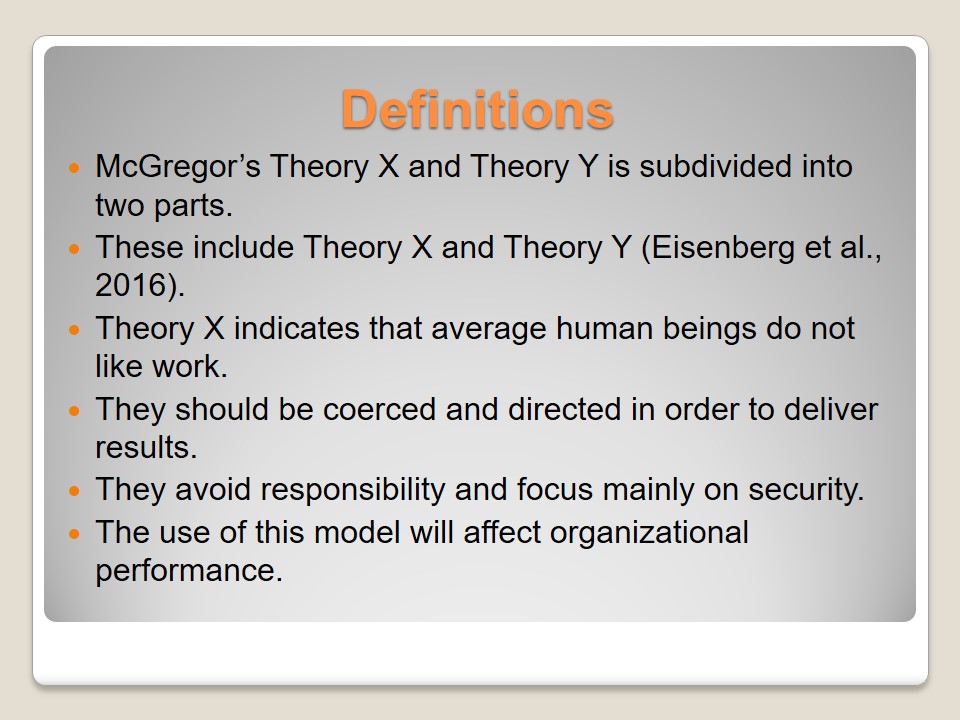
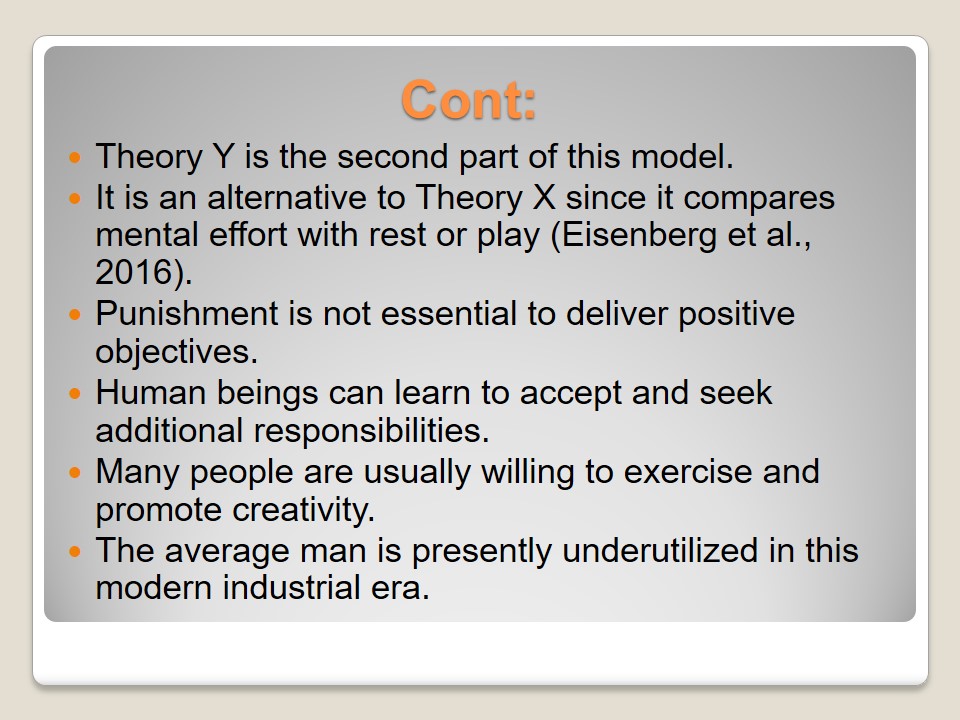
Strengths
- This theory is easy to understand and interpret.
- It is applicable in both autocratic and demographic organizations.
- Managers can utilize it to empower and guide employees depending on their traits (Eisenberg et al., 2016).
- It views organizations as non-rigid depending on the existing situations.
- Individuals can pursue it to become more productive in their lives or careers.
- It offers powerful guidelines for thinking about work.
McGregor’s Theory X and Theory Y remains one of the easiest models to apply in business organizations. Managers who rely on it will focus on the best thoughts and implement evidence-based strategies for executing activities or responsibilities. The model can also be personalized depending on the existing environments and personal goals.
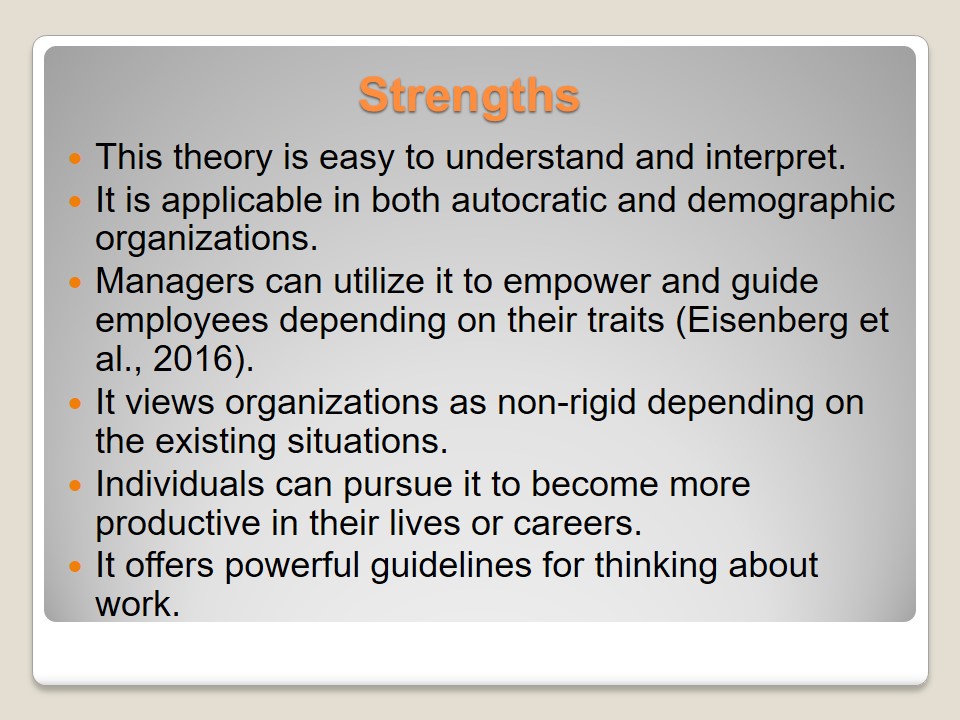
Weaknesses
- McGregor’s theory presents several weaknesses that make it inapplicable in different scenarios.
- Firstly, it is too simplistic to implement in serious organizations or firms.
- Secondly, it only focuses on two approaches for managing employees.
- Thirdly, it assumes that people belong to specific attitude extremes regarding work (Eisenberg et al., 2016).
- Fourthly, it fails to offer evidence-based procedures for implementing it in different settings.
- Finally, it assumes that the adoption of Theory Y will remove the attitudes outlined in Theory X.
This model has received criticism from different theorists since it only categorizes people into two attitude extremes. Consequently, it ignores the presence of individuals with diverse temperaments who require appropriate support. It also fails to offer detailed strategies for engaging workers and ensuring that positive results are recorded. Its simplistic nature makes it less applicable in a wide range of organizations or scenarios. When leaders decide to select any of the two parts, chances are high that they will be ignoring the expectations and intrinsic values of different workers.
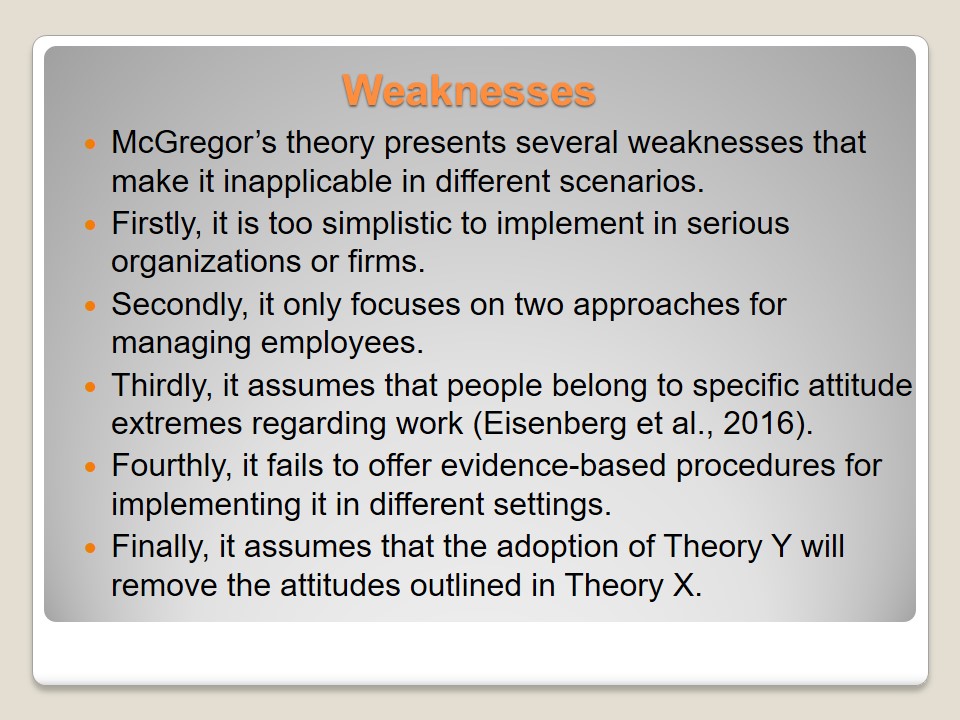
Application to Life and Work
- McGregor’s Theory X and Theory is applicable in a person’s life or work to deliver desirable outcomes.
- When people appreciate the fact that work is unpleasant, they will be willing to complete additional duties to attain security.
- Those in leadership positions will guide their followers to emerge successful.
- People can avoid the attributes of Theory X and promote those outlined in Theory Y.
- When one is self-motivated and committed, chances are high that he or she will remain responsible (Eisenberg et al., 2016).
- Human beings can embrace the concepts of innovation and creativity to solve organizational problems.
- This model by McGregor can guide individuals to focus on positive achievements.
- It encourages me to should tap my maximum potential.
- It empowers me to find solutions to every existing or identified problem.
- I can focus on my intrinsic values to be in control of my thoughts and remain committed.
- I will eventually seek additional responsibilities and present reasonable solutions.
- Similar concepts will ensure that many people emerge successful in their fields.
The ideas and concepts outlined in this theory can guide people to appreciate the fact that work is quite demanding on unrewarding. With this kind of understanding, they will be ready to seek appropriate support or guidance from their superiors. This practice will equip them with additional skills and competencies for overcoming most of the challenges they face. They will go further to take up leadership roles in an attempt to change their respective situations (Eisenberg et al., 2016). The adoption of Theory Y will make it easier for them to become more involved, innovative, and eventually emerge successful in their respective careers.
When McGregor’s Theory X and Theory Y in applied in a person’s life, chances are high that a new form of thinking will emerge that delivers immediate solutions (Eisenberg et al., 2016). It is a powerful tool for engaging in self-reflection and focusing on the most appropriate strategies for becoming more responsible and successful. People should learn to focus on their goals and remain committed in every activity they are undertaking.

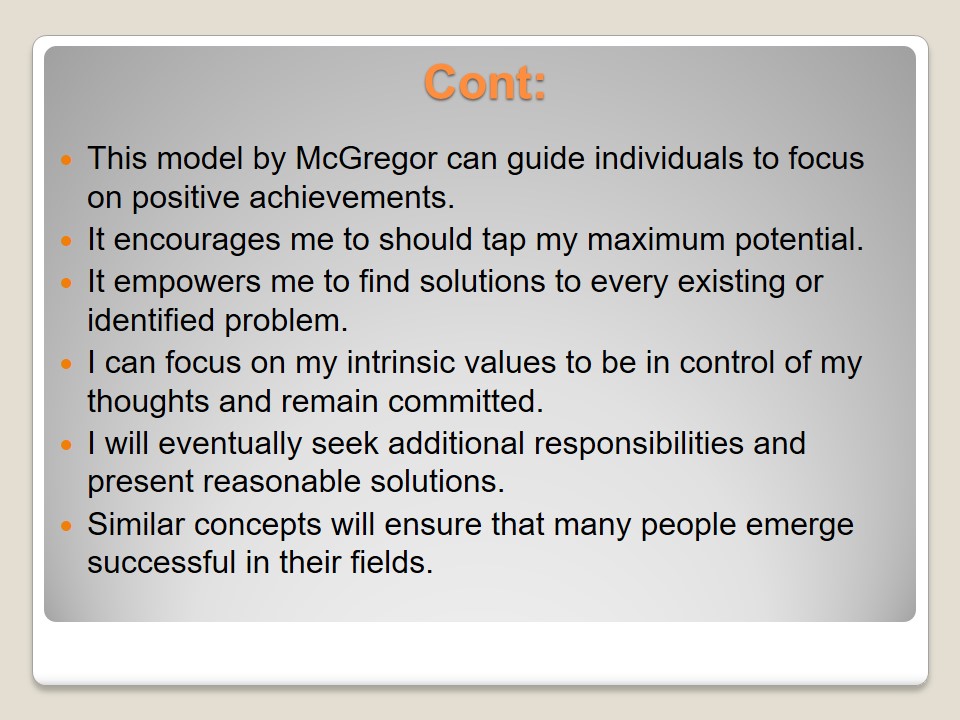
Conclusion
- McGregor’s Theory X and Y has remained a powerful model for solving organizational and personal problems.
- Its two parts are applicable in diverse settings.
- It is understandable and capable of guiding leaders to present unique solutions to specific problems.
- When applied in personal careers or goals, chances are high that it can deliver desirable results.
- Nonetheless, it is too simple and incapable of addressing the needs of people with various expectations or temperaments.
- Those using it should, therefore, be aware of such drawbacks.
The above discussion has presented McGregor’s Theory X and Theory Y as a unique model for guiding organizational goals and activities. Employees should be aware of the issues, gaps, and strengths associated with it in order to apply it effectively depending on the targeted situation. The ultimate objective is to increase profitability or maximize personal achievements.
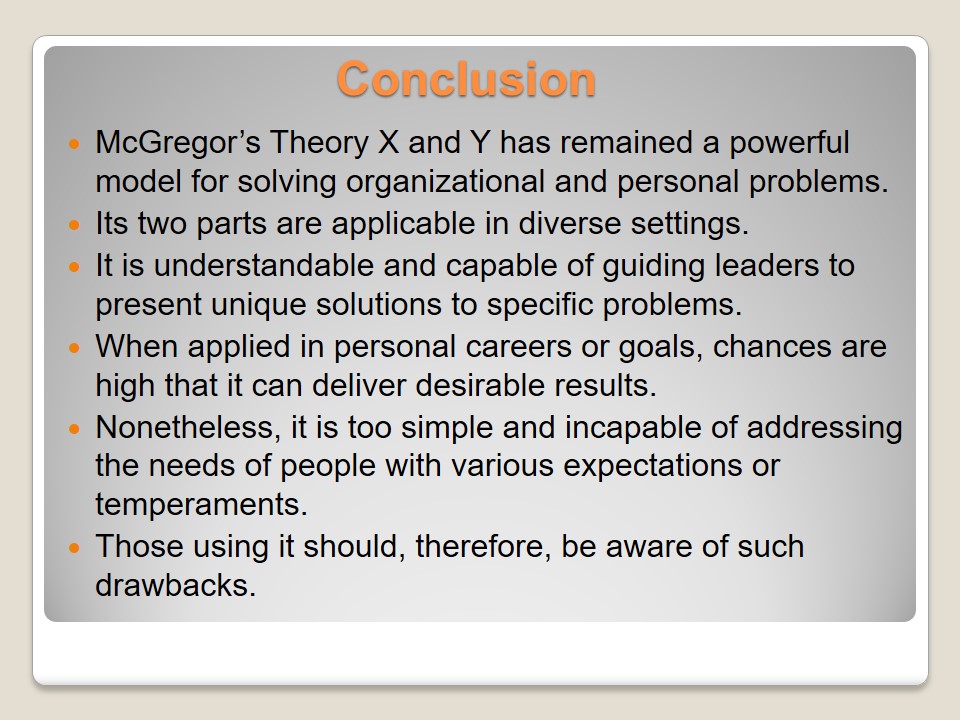
Reference
Eisenberg, E. M., Trethewey, A., LeGreco, M., & Goodall, H. L. (2016). Organizational communication: Balancing creativity and constraint (8th ed.). Boston, MA: Bedford/St. Martin’s.